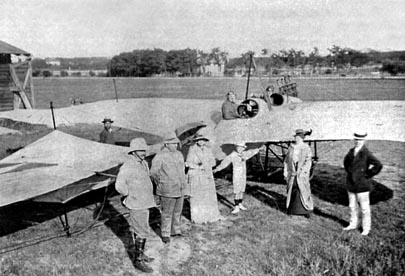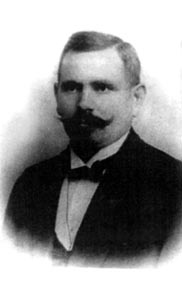 | ||
 |
 |
 |
 |
 |
| The Aircraft That Never Flew © Lennart Andersson |
||
 Oster's aircraft after completion. The Chinese characters read, "Built in the fourth Shantung arsenal". |
||
A small number of Germans moved to China and designed and built a few aircraft there. One of them was Franz Oster. Unfortunately nobody wanted to fly his aircraft ... German engineer Franz Oster was hired on 1 June 1926 by General Pi Shu-chen, head of the Tsingtao arsenal in the Province of Shantung in north-eastern China, as a technical adviser. He was born on 19 January 1869 and in 1911 he had learnt to fly and received German pilot certificate No 94. In the same year he bought an example of one of the early aircraft types, an Etrich-Rumpler-Taube, which he brought with him to Kiauchow and flew there. Kiauchow was at that time a small German concession area around the city of Tsingtao. He was taken to Japan as a prisoner of war during the Second World War, but later returned to Tsingtao. 
Franz Oster's Etrich-Rumpler-Taube in Kiauchow, 1913. Oster was ordered by he warlord of Shantung, Chang Tsung-ch'ang, to build an aircraft for the local air force, and drawings were apparently acquired from the Caspar firm in Travemünde. Oster started to work on the design of the aircraft in April 1927 and on 16 December it was completed. It was powered by a 230 hp BMW engine and imported German instruments had been fitted, Otherwise Chinese materials had been used. The aircraft was biplane with four seats arranged two and two in separate cockpits. It was about 8 m long and its span was 12 m. Chinese characters for "Built in the Fourth Shantung Arsenal" were painted on the side of the fuselage. On 25 December 1927 Oster's aircraft was sent by train to Tsinan, the capital of Shantung, and taken to the Shantung air force aerodrome near the city, where it was to be test-flown. It probably never left the ground, because the Chinese pilots refused to fly it, as it was found to be excessively overweight and also had other faults. Oster had made a gross mistake when calculating the aircraft's weight and its controls were hard and clumsy to operate. The Shantung air force was equipped with modern all metal Junkers K 53 monoplanes, and the pilots regarded Oster's aircraft with suspicion. The so-called National Pacification Army under Manchurian warlord Chang Tso-lin, who was closely allied to Chang Tsung-ch'ang during the civil war that was raging in China, had managed during 1927 to resist the expansion of Chiang Kai Shek and the Nationalist's Northern Expedition. When Nationalist troops gained the upper hand, Chang Tsung-ch'ang's troop had to retreat to the north. At this time the aircraft inventory of the Shantung air force consisted of six Junkers K 53s, two Udet U 12 Flamingos, three Breguet 14s, one Caudron C.59, one Avro 504K, five Potez VIIIs, one Heinkel HD 24, one Vickers VIM - and the Oster aircraft. When the Nationalist Army advanced into Shantung in April 1928 the Shantung troops managed to bring all their aircraft, except for the worthless Oster machine, to Manchuria, where they were incorporated into the Manchurian air force. Oster died on 19 July 1933 in Tsingtao.
Franz Oster.
| |
| (c) Lennart Andersson |
